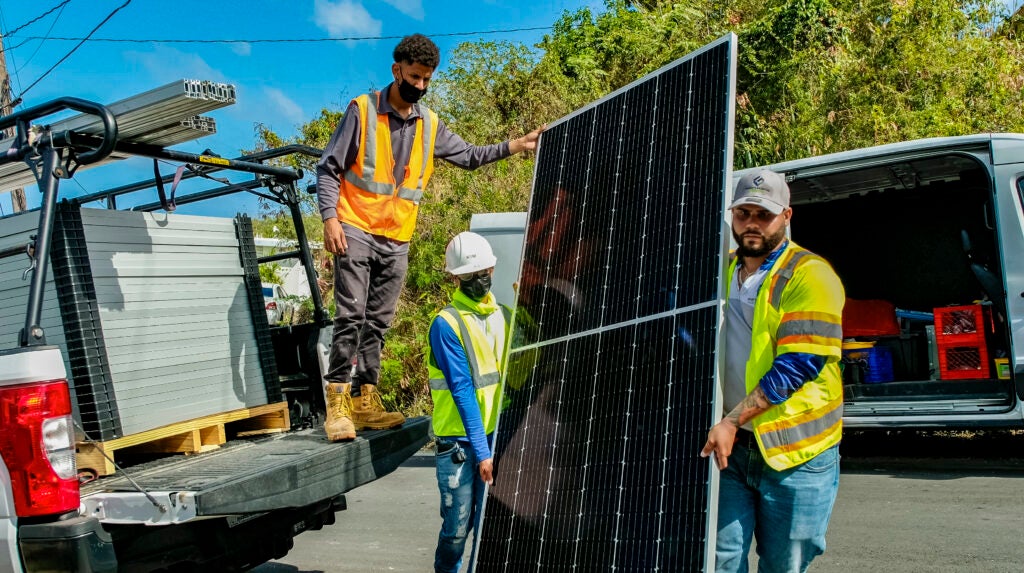The results of the Puerto Rico Grid Resilience and Transitions to 100% Renewable Energy Study (PR100) contain an important conclusion: “Puerto Rico can make a feasible transition to 100% renewable energy by 2050, but significant improvements and investments in the system, guided by meaningful community participation, are necessary to achieve this.”
After the deaths and environmental impacts of hurricanes Irma and María in 2017, Puerto Rico needed a science-based plan that would demonstrate alternatives — where and how we should go to comply with the provisions of the Energy Public Policy Act, Law 17, which requires the island to generate all its electricity from renewable sources by 2050.
The Meaning of PR100 for the communities of Puerto Rico Click To Tweet
The PR100 study was conducted by the U.S. Department of Energy’s Office of Grid Deployment and six national laboratories with financing from the Federal Emergency Management Agency. Its objective is to comprehensively analyze stakeholder-driven pathways toward Puerto Rico’s clean energy future. It took two years for this analysis to be ready and its general conclusions were presented at the beginning of February. But what do the findings mean for Puerto Ricans?
To achieve energy resilience and foster a true sense of environmental justice in Puerto Rico, the results of this study must be accessible and presented in simple terms to leaders and communities currently working to address the needs of their neighbors. Puerto Rico has the potential to serve as a model for other Caribbean jurisdictions and promote communities to be protagonists of the energy transition processes.
It is not enough to provide technical and complex information about the reality of the electrical system and its instability. This information must be broken down, explained, and supported by communities to ensure a rapid and effective recovery after natural disasters. In addition, it is necessary to understand the capabilities, resources and experience that we have available on the ground and adjust our course of action to the realities and limitations of each region.
People’s priority continues to be to quickly address the energy needs of the most vulnerable populations and avoid prolonged blackouts. To promote community integration in the electricity grid transformation processes, government entities in charge of implementing Law 17 of 2019 can — and should — design and commit to continuous community participation processes. Beyond facilitating the implementation of what PR100 recommends, it is necessary that local processes be supported and respected and that leadership and their skills be strengthened, so that they can help in reducing Puerto Rico’s dependence on fossil fuels. It is important to understand all stakeholder and their roles in the development process, implementation and follow-up of solar energy community-based projects to ensure their success in the future.
In its executive summary, the PR100 study concluded that “while it is technically feasible in Puerto Rico to build a robust system based on 100% renewable energy by 2050, significant system improvements and investments, guided by meaningful community participation, are necessary now and in the future to achieve this vision.”
Organizations such as the Environmental Defense Fund, Interstate Renewable Energy Council, Casa Pueblo, Mountain Hydroelectric Cooperative, Energy Justice and Hispanic Federation, among others, are entities that act as advocates for local interests. These organizations provide technical support, which in collaboration with local leaders and organizations, must ensure that the design of renewable energy projects responds to the community’s vision. For this, it is important to have a degree of governance and community organization that will lead the process and can continue to represent the community, as the energy future of Puerto Rico is being designed. It is important to understand all stakeholders and their respective roles in the development, implementation and monitoring process of solar energy projects.
The results of PR100 present an opportunity to work on community integration, promote education and the responsible and effective use of new clean, affordable and reliable energy technologies. If effectively adopted, they could light the way for other Caribbean islands.


